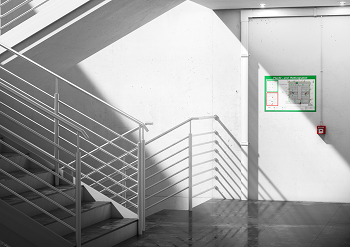
Protection aim 2: Secure escape and rescue routes
The division of building into fire sections protects unaffected building sections against the spread of fires for specific periods of time. Insulation maintains the fire sections, thus limiting the spread of fire and smoke. These constructive measures protect people and property, allowing fire brigades to prevent the spread of fires to other parts of the building through extinguishing measures.
Protection of escape routes
What is an escape and rescue route?
According to the building regulations, there must be routes in buildings, which not only permit access to the building in a horizontal and vertical direction in normal situations, but which also offer the option of rescue in case of fire. It is therefore obligatory to equip buildings with at least one constructive escape and rescue route. Additional escape and rescue routes may also be necessary, depending on the type of building.
These include:
- Necessary stairwells
(vertical access) - Connecting rooms between the necessary stairwells and exits to the outside
- Necessary corridors
(horizontal access)
There must be a guarantee that, if there is a fire, these routes can be used to leave the building without any risk. In addition to evacuation, the escape and rescue routes also aid the local fire brigades as a point of attack.
Tutorials on the subject of escape routes
Simply explained, comprehensively protected. Our tutorials explain exactly what is important with the second protection aim.






